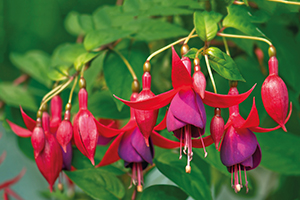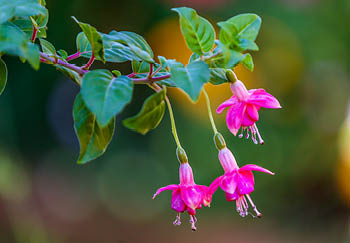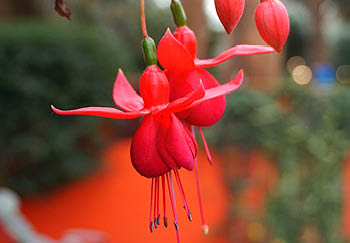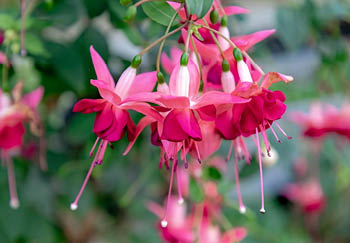Fascinating Fuchsias
June 15th, 2021 | Categories
Sarah Squire explores the origins and caring of the tender perennial Fuchsia.
I was wandering around my garden pondering what to write about when I was struck by the beauty of a particular Fuchsia in a basket. It has the most wonderful pendulous flowers amongst dark green foliage and is called Linda Grace.
Fuchsias belong to the Onagraceae family and are related to the Evening primrose (Oenothera) and Clarkias. They have tubular flowers. Often the petals are one colour and the tube another. Varieties which have an upright habit maybe grown as compact bushes or trained as standards. The trailing varieties are ideal for hanging baskets.

For colour try Swingtime with its red tubes and cream petals (this, like many other Fuschias can also be grown as a standard), Thalia with red tubes and orangey red petals and the glorious double flowered creamy pink flowers of Annabel. If you want these half hardy or tender varieties to survive the winter they will need to be brought inside for the duration as soon as there is a danger of frost.

Fuchsias can be deciduous or evergreen and some are hardier than others. If you want to keep your Fuchsias outside all year round look for varieties such as Dollar Princess (3ft) which has cerise – red tubes and purple petals, Mrs. Popple (5ft) or if you are after a dwarf shrub Tom Thumb and Lady Thumb which grow to only 20”. All these plants will give you some good summer colour and should go on flowering until the autumn. However, the hardy subjects tend to have smaller, less showy blooms than their half hardy and tender cousins.

Fuchsias prefer a sheltered partly shaded spot. They enjoy a high nitrogen feed to promote luxuriant foliage and plenty of potash when flowering.

Fuchsias are easy to propagate at home from cuttings. These can be taken at any time from about April to September. Cut three to four inches from a non flowering shoot. Remove all leaves from the bottom half of the cutting. Trim the stem and, if you wish, dip in hormone rooting powder. Fill a small pot with seed compost and carefully push the cuttings into the compost around the edge of the pot. The compost should come to just below the lowest leaves. Place a plastic bag over the pot to help keep the moisture in and place the cuttings in a cool shady spot. The cuttings should be ready for potting on in about two weeks. To encourage bushier plants nip out the growing tip which will stimulate the growth of side shoots.

Useful Links
- Shop Online for Fuchsias
- Fuchsia Growing Guide (Article)
- Growing Guides (Articles)
- Summer Gardening (Articles)
- Social Gardening (Article)






